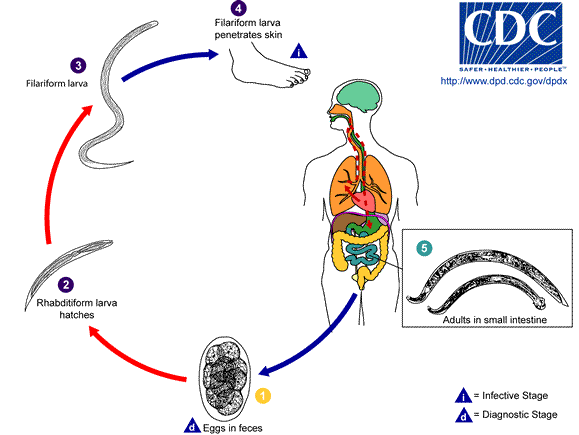Hookworms
"What’s Eating You, Lazybones?"
by Mandy Foss
Reprinted with permission from the Tar Heel Junior Historian. Fall 2008; Revised October 2022.
Tar Heel Junior Historian Association, NC Museum of History
In the beginning of the twentieth century, a battle was fought in North Carolina and ten other southern states. From 1909 to 1914, doctors, public health officials, and northern businessmen worked to destroy what they called the "germ of laziness." They believed such a germ caused many of the South's problems—poverty, a sickly population, and economic underdevelopment. But the germ these people were attacking wasn't a germ at all. It was a worm—the hookworm.
 Hookworm disease was one of three major diseases that had plagued the South since the early 1800s. Along with malaria and yellow fever, hookworm disease came from Africa during the Trans-Atlantic Slave Trade. Hookworms are parasites. Parasites survive by feeding off a living host. Less than half an inch long, white adult hookworms attach themselves to a person's small intestine and feed on blood. A female hookworm can lay thousands of eggs every day. The eggs exit the host's body through feces. Once the eggs hatch, hookworm larvae look for a new host.
Hookworm disease was one of three major diseases that had plagued the South since the early 1800s. Along with malaria and yellow fever, hookworm disease came from Africa during the Trans-Atlantic Slave Trade. Hookworms are parasites. Parasites survive by feeding off a living host. Less than half an inch long, white adult hookworms attach themselves to a person's small intestine and feed on blood. A female hookworm can lay thousands of eggs every day. The eggs exit the host's body through feces. Once the eggs hatch, hookworm larvae look for a new host.
In the early 1900s, many North Carolinians did not have bathrooms inside or outside their homes. People used the great outdoors or chamber pots—containers kept under the bed mainly for nighttime bathroom breaks and dumped outside the next morning. They often did not wear shoes because of the warm climate and a lack of money. When southerners walked barefooted through feces-contaminated soil, they might touch hookworm larvae. The threadlike larvae could enter a person's body through the skin—usually the foot. This caused a rash called ground itch. The larvae traveled through the body to the small intestine.
One historian estimated that between 1865 and 1910, 40 percent of the South's population suffered from hookworms. Thousands of worms could live in a person at one time. All these parasites and their constant bloodsucking made an infected person pale and tired. To northerners, southerners with hookworm disease appeared lazy and stupid. But hookworms caused serious health problems. They stunted growth in children and weakened resistance to germs. Weakened bodies could not fight off other—often fatal—diseases.
Physician Charles Stiles believed that ridding the South of hookworm disease would solve many problems. He thought southerners, once cured, would become more productive workers and citizens. In 1902, after conducting infection surveys, Stiles published research showing widespread hookworm infections. Based on this research, in 1909 northern philanthropist John D. Rockefeller donated $1 million to form the Rockefeller Sanitary Commission to Eradicate Hookworm Disease, or RSC. RSC's huge health campaign had three goals: to survey eleven southern states to determine how many people had hookworm disease; to cure the infected; and to remove the disease source by ending soil pollution. Doctors, educators, and public health inspectors went county-by-county to test for and treat hookworms. Those infected were dosed with thymol pills to kill the worms and Epsom salts to flush them out of the body. To prevent reinfection, people were encouraged to wear shoes and to build and use sanitary outhouses (or outdoor bathrooms similar to today's portable toilets). Sanitary outhouses kept waste matter away from people, animals, insects, and nearby water supplies.
By 1915, RSC ended its southern hookworm campaign. Though reformers had some success battling hookworms, the South's poverty and underdeveloped economy remained. The campaign did, however, make people more aware of the link between cleanliness and the spread of disease. More southerners began wearing shoes, building sanitary outhouses, and taking regular "worming" treatments. And while the germ of laziness was never defeated outright, it has been on the run ever since.
References:
"Hookworm" in the North Carolina Digital Collections.
"Hookworm in the United States" in NC LIVE.
"Hookworm" in UNC-Chapel Hill's "Documenting the American South."
"Hookworm in the Southern States" in WorldCat.
1 January 2008 | Foss, Mandy